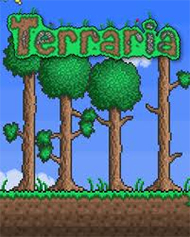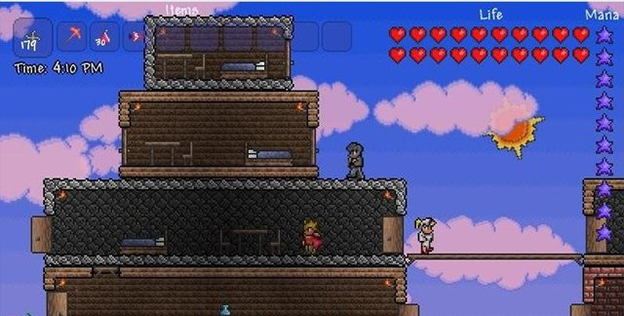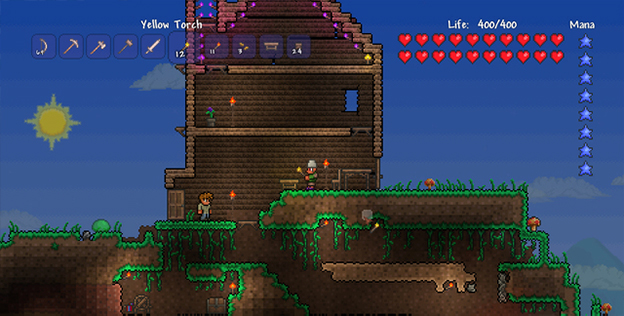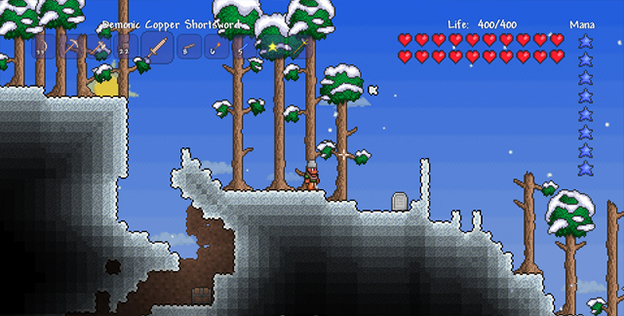 Deep They Delved
Deep They Delvedby Josh Wirtanen
When Terraria first hit Steam back in 2011, Minecraft was in the middle of tearing up sales charts, so comparisons between the two games were inevitable. While calling Terraria game “a 2D version of Minecraft” may be somewhat accurate, it also ignores the fact that what makes this game so much fun are the pieces it didn’t borrow from Notch’s famous sandbox game. And now that Terraria has arrived on consoles, it’s the perfect time to take another look at it.
I must say, as someone who has spent dozens of hours in the PC version of the game, it was a pleasant surprise to have the Xbox 360 Edition of the game end up in my review pile for this month. Firing up Terraria for the first time in about a year, I was greeted with the familiar pixilated splash screen, and it wasn’t long before I was bobbing my head to the same retro-inspired soundtrack I had fallen in love with during my time with the PC version two summers ago. It was instantly familiar, yet, with the game’s randomly generated terrain, it also felt completely new. There was a fresh and untamed world just waiting to be settled by a brave explorer like Buster, the character I had created especially for this review.

For the uninitiated, here’s how Terraria works: When you launch the game, you create a character, then send him or her (unlike Minecraft, gender does exist in Terraria) into a randomly generated, pixellated 2D world. What you do from this point is entirely up to you, though it’s recommended that you build a shelter as soon as possible. (Also unlike Minecraft, you actually start a Terraria world with a few tools that will be immediately useful.)
Your other options include exploring the surface (which basically means choosing left or right and then walking as far in that direction as you can), spelunking, mining, collecting various items, or engaging monsters in combat. Of course, there is a tiered crafting system that has you building basic tools, which you’ll use to acquire the materials to make better tools, which you’ll then use to collect even better materials, and so on. It’s a fairly smooth natural progression that keeps the game moving, and it even encourages you to take on some of the game’s various boss battles in order to acquire rare materials you can’t get elsewhere. Once you feel ready, of course; the beauty of Terraria is that it lets you move at your own pace.

The look of Terraria is almost comparable to a Super NES-era RPG. While that sounds like a weird artistic choice for a survival/crafting/exploration game, it actually works quite well. It simultaneously makes the game feel stylized and allows the processor on your console to load insanely large random worlds without slowing to a halt. (Though, it must be noted that you will encounter some noticeable frame rate drops in the 360 Edition, especially when you travel across multiple biomes quickly.)
Unfortunately for console owners, this game was built from the ground up as a PC game, thus the control scheme was designed with a keyboard and mouse in mind. Transitioning to a console controller makes mining a bit awkward. There are two different options for how you’d like your cursor to function, and you can toggle between them by pressing down on the right stick. Still, neither of them is as intuitive as simply using a mouse.

On the other hand, combat becomes much easier. Personally, I always felt the point-and-click combat of the PC version to be less than optimal, and getting to use a standard controller made me into a more versatile monster-fighting machine. Additionally, you can assign various tools or items to the D-pad, which makes swapping between your sword and tools an effortless affair.
Source: http://www.cheatcc.com
No comments:
Post a Comment